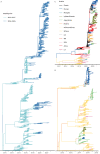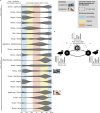Synchrony of Bird Migration with Global Dispersal of Avian Influenza Reveals Exposed Bird Orders
- PMID: 38321046
- PMCID: PMC10847442
- DOI: 10.1038/s41467-024-45462-1
Synchrony of Bird Migration with Global Dispersal of Avian Influenza Reveals Exposed Bird Orders
Abstract
Highly pathogenic avian influenza virus (HPAIV) A H5, particularly clade 2.3.4.4, has caused worldwide outbreaks in domestic poultry, occasional spillover to humans, and increasing deaths of diverse species of wild birds since 2014. Wild bird migration is currently acknowledged as an important ecological process contributing to the global dispersal of HPAIV H5. However, this mechanism has not been quantified using bird movement data from different species, and the timing and location of exposure of different species is unclear. We sought to explore these questions through phylodynamic analyses based on empirical data of bird movement tracking and virus genome sequences of clade 2.3.4.4 and 2.3.2.1. First, we demonstrate that seasonal bird migration can explain salient features of the global dispersal of clade 2.3.4.4. Second, we detect synchrony between the seasonality of bird annual cycle phases and virus lineage movements. We reveal the differing exposed bird orders at geographical origins and destinations of HPAIV H5 clade 2.3.4.4 lineage movements, including relatively under-discussed orders. Our study provides a phylodynamic framework that links the bird movement ecology and genomic epidemiology of avian influenza; it highlights the importance of integrating bird behavior and life history in avian influenza studies.
© 2024. The Author(s).
Conflict of interest statement
The authors declare no competing interests.
Figures



References
-
- Wille, M. & Barr, I. G. Resurgence of avian influenza virus. 376, 459–460. https://www.science.org/doi/10.1126/science.abo1232. - DOI - PubMed
-
- 2020: OIE - World Organisation for Animal Health. https://www.oie.int/animal-health-in-the-world/update-on-avian-influenza....
MeSH terms
Grants and funding
LinkOut - more resources
Full Text Sources
Medical

